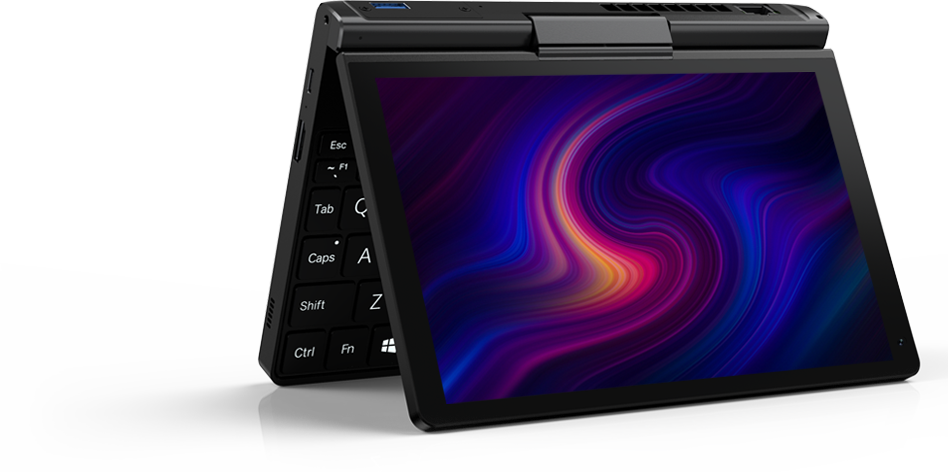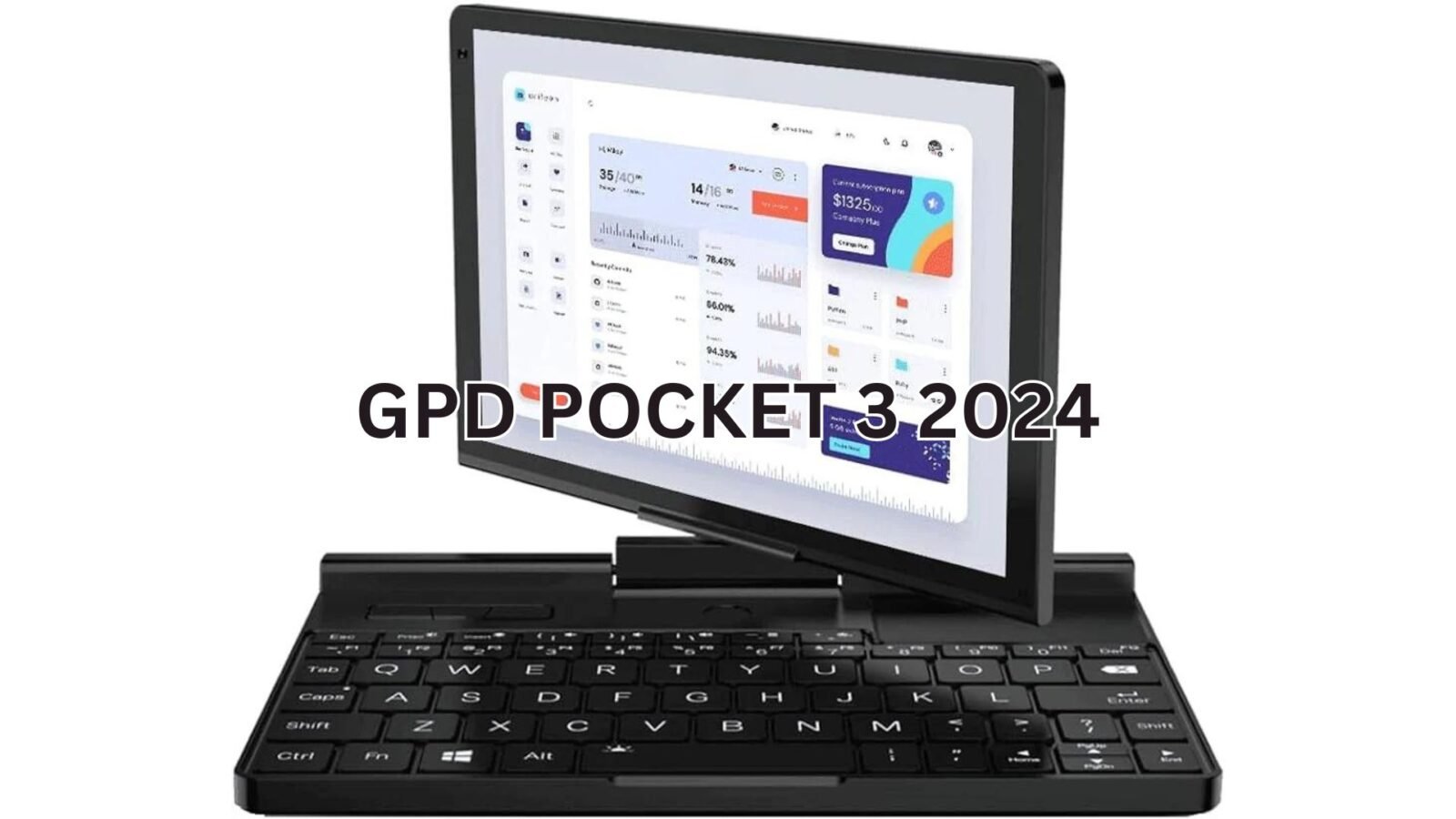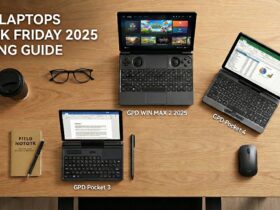GPD har oppdatert sin Pocket 3 mini-laptop for 2023, og oppgradert innstegsmodellen med en kraftigere Intel Pentium Gold 7505-prosessor og 16 GB RAM. Den oppdaterte Pocket 3 har forbedret enkeltkjerneytelse og grafikkfunksjoner sammenlignet med den forrige versjonen med Pentium Silver N6000-brikken.
GPD Pocket 3 2024 Spesifikasjoner

liliputing.com
GPD Pocket 3 2024-oppdateringen gir noen bemerkelsesverdige oppgraderinger av spesifikasjonene til innstegsmodellen av denne allsidige mini-laptopen:
2024-modellen har en raskere Pentium Gold 7505-prosessor og dobbelt så mye RAM sammenlignet med den forrige Pentium Silver N6000-versjonen. Thunderbolt 4-støtte er også lagt til, noe som muliggjør eGPU-tilkobling. Disse oppgraderingene gir et betydelig ytelsesløft, samtidig som Pocket 3s ultrabærbare formfaktor og allsidige funksjoner, som den 180° roterbare berøringsskjermen, opprettholdes.
Uanstrengt 180° svingbar skjerm

GPD Pocket 3s 180° roterbare berøringsskjerm er en av de mest unike og allsidige funksjonene, og den byr på flere fordeler:
- Innovativ hengseldesign: Pocket 3 har et spesialkonstruert hengsel med avansert pulvermetallurgiteknologi som gjør det mulig å rotere skjermen 180° rundt Y-aksen med én hånd. Dette gjør det enkelt å veksle mellom bærbar PC og nettbrett.
- Utmerket holdbarhet: GPDs robuste hengsel har bevist sin pålitelighet, og har i laboratorietester bestått 100 000 kontinuerlige rotasjons-, åpnings- og lukkeoperasjoner med en imponerende pålitelighetsgrad på 99,3 %.
- Automatisk skjermrotasjon: I motsetning til noen tidligere prototyper har den endelige Pocket 3 en gyroskopsensor som registrerer skjermretningen og automatisk justerer mellom liggende og stående modus etter behov når den er i nettbrettform.
- Skjermpanel av høy kvalitet: Den 8-tommers IPS-berøringsskjermen har en skarp oppløsning på 1920×1200, 500 nit lysstyrke og 100 % sRGB-fargespekter for et levende og detaljert bilde. Bildeforholdet 16:10 er ideelt for både produktivitet og mediekonsum.
- Støtte for presisjonspenn: Med Microsoft Pen Protocol 2.0-kompatibilitet og 4096 nivåer av trykkfølsomhet fungerer Pocket 3s berøringsskjerm sømløst med en aktiv penn for flytende håndskrift, skissering og presis kontroll. Håndflateavvisningsteknologi forhindrer utilsiktet inntasting.
- Allsidige bruksmoduser: Med 180°-hengslet kan Pocket 3 brukes i standard bærbar PC-modus, nettbrettmodus for notater og tegning, teltmodus for presentasjoner eller media og stativmodus for berøringsbasert interaksjon.
GPD Pocket 3 kombinerer en produktivitetsfokusert minibærbar datamaskin med en digital skriveskifer av høy kvalitet, og GPD Pocket 3s unike design med sammenleggbar berøringsskjerm gir uovertruffen fleksibilitet for en så bærbar enhet.
Stylus-støtte for presisjon

GPD Pocket 3 mini-laptop har utmerket støtte for penn, noe som gjør den til et allsidig verktøy for digital skriving, skissering og presis navigering. Den er kompatibel med aktive penner som bruker Microsoft Pen Protocol 2.0, for eksempel Surface Pen og den offisielle GPD Pocket 3-penn. Med 4096 nivåer av trykkfølsomhet muliggjør pennen i Pocket 3 naturlig, presis håndskrift og tegning som føles som å bruke en penn på papir. Den høye trykkfølsomheten gjør det mulig å lage uttrykksfulle streker med varierende strektykkelse avhengig av hvor hardt du trykker. Håndflateavvisningsteknologi forhindrer utilsiktet inntasting fra hånden mens du skriver eller tegner.Pennen på Pocket 3 er ideell for å ta håndskrevne notater, kommentere dokumenter eller PDF-filer, skissere ideer, lage kunstverk og signere digitale dokumenter. Det gir en komfortabel og intuitiv måte å samhandle med berøringsskjermen på, spesielt når Pocket 3 er foldet sammen til nettbrettmodus ved hjelp av den 180° roterbare skjermen.For brukere som foretrekker håndskrift fremfor maskinskriving, eller som har behov for å tegne diagrammer og visualiseringer, er Pocket 3s utmerkede støtte for stylus en nøkkelfunksjon. Den muliggjør friksjonsfri digital blekkinnføring i en svært bærbar formfaktor, noe som gjør Pocket 3 til et overbevisende verktøy for studenter, kunstnere, designere og profesjonelle som trenger å skrive eller tegne på farten.
180° roterbar berøringsskjerm

GPD Pocket 3 har en innovativ 180-graders roterbar berøringsskjerm som gjør det mulig å konvertere minibærbare datamaskiner til nettbrett. Ved hjelp av avansert pulvermetallurgiteknologi kan skjermen enkelt roteres med én hånd slik at den vender bort fra tastaturet og foldes flatt mot baksiden av enheten. I nettbrettmodus støtter Pocket 3s 8-tommers IPS-skjerm på 1920×1200 tommer 10-punkts multiberøring og er kompatibel med en aktiv penn, noe som muliggjør presis håndskrift, skissering og navigering. Med 4096 nivåer av trykkfølsomhet gir Pocket 3 en naturlig penn-på-papir-følelse for å ta notater, kommentere dokumenter eller lage digitale kunstverk mens du er på farten.Pocket 3s unike svingbare hengsel har gjennomgått omfattende holdbarhetstester, og har tålt over 100 000 kontinuerlige åpne/lukke-sykluser med en pålitelighetsgrad på 99,3 %. En gyroskopsensor justerer automatisk skjermretningen basert på hvordan enheten holdes, og veksler mellom liggende og stående modus.GPD Pocket 3 kombinerer en produktivitetsfokusert minibærbar PC med en digital notatblokk og skissebok, og den allsidige 180-graders sammenleggbare berøringsskjermen gir en overbevisende løsning for både arbeid og kreativitet i en svært bærbar formfaktor.
KVM-funksjonalitet på Pocket 3

GPD Pocket 3 inneholder en unik KVM-modul (tastatur, video, mus) som gjør det mulig å styre servere og andre enheter. Denne KVM-funksjonaliteten gjør Pocket 3 til et allsidig verktøy for IT-profesjonelle og systemadministratorer. Med KVM-modulen tilkoblet kan Pocket 3 kobles til servere eller datamaskiner som mangler tastatur og mus, og styre dem ved hjelp av Pocket 3s egne inngangsenheter.1 Skjermen på Pocket 3 viser videoutgangen fra den tilkoblede enheten.1 Dette kan være svært praktisk for å administrere hodeløse systemer eller få tilgang til maskiner i et serverrom. KVM-funksjonen fungerer med både Windows- og Linux-operativsystemer på Pocket 3.1 Det er ikke nødvendig med spesielle drivere eller konfigurasjon - videosignalet fra den tilkoblede enheten vises som et webkamera som kan vises med apper som VLC eller OBS, og tastatur/mus-kontrollen håndteres i maskinvaren. I tillegg til servere gjør KVM-modulen det også mulig å koble til industrimaskiner og annet utstyr. RS-232 seriell modul kan brukes til f.eks. feilsøking av innebygde systemer eller styring av CNC-maskiner.KVM-funksjonaliteten gir den allerede svært bærbare og kapable GPD Pocket 3 stor fleksibilitet. Det er en enestående funksjon for brukere som trenger å administrere IT-infrastruktur eller kommunisere med spesialiserte enheter mens de er på farten.1
RS-232 for spesialiserte bruksområder

GPD Pocket 3 har en valgfri RS-232 seriell portmodul som gjør det mulig å integrere et ekte RS-232-grensesnitt, noe som gjør den nyttig for en rekke industrielle og kommersielle bruksområder. Noen av de viktigste bruksområdene for RS-232-porten på Pocket 3 er
- Feilsøking av systemet: RS-232-porten gjør det mulig å koble til innebygde systemer og andre enheter for feilsøking og diagnostikk på lavt nivå. Mange industrielle kontrollere, vitenskapelige instrumenter og nettverksutstyr er fortsatt avhengige av serielle porter for konfigurasjon og feilsøking.
- Grensesnitt mot CNC-maskiner: RS-232-modulen gjør Pocket 3 godt egnet til å betjene profesjonelle CNC-fresemaskiner og annet datastyrt numerisk kontrollutstyr som bruker seriell kommunikasjon.
- Støtte for eldre enheter: Mange eldre enheter, som kassasystemer, strekkodeskannere, laboratorieinstrumenter og automatiseringsstyringer, har bare RS-232-porter og kan kobles til ved hjelp av Pocket 3s seriemodul.
- Feltservice og prosjektering: Pocket 3 med RS-232 er en bærbar løsning for feltteknikere og ingeniører som trenger å koble seg til serielt utstyr for vedlikehold, oppgraderinger og reparasjoner mens de er ute på eksterne steder.
RS-232-modulen kan byttes ut med standard USB-A- eller KVM-moduler på Pocket 3, slik at enheten kan tilpasses til ulike bruksområder. Den modulære designen gjør Pocket 3 til et bærbart og fleksibelt verktøy for både IT- og OT-applikasjoner (operativ teknologi) som krever seriell tilkobling.
Økt ytelse med Pentium Gold 7505

Intel Pentium Gold 7505-prosessoren gir GPD Pocket 3 2024 mini-laptopen et betydelig ytelsesløft sammenlignet med den tidligere Pentium Silver N6000-modellen. 7505 er basert på Intels Tiger Lake-U-arkitektur og har 2 kjerner og 4 tråder med en basisfrekvens på 2,0 GHz og en maksimal turbofrekvens på 3,5 GHz. Den integrerer også Intels nye Xe-grafikk, som gir vesentlig bedre grafikkytelse enn den eldre UHD Graphics. Pentium Gold 7505 er fortsatt en innstegsbrikke, men den er ca. 19 % raskere enn Microsoft SQ2-prosessoren og bare litt bak Core i3-1005G1, noe som gjør den i stand til å utføre grunnleggende databehandlingsoppgaver. 7505s 10 nm SuperFin-design muliggjør denne ytelsen i en strømeffektiv 15 W-pakke som er egnet for et kompakt system som GPD Pocket.
Grafikkoppgradering over N6000

GPD Pocket 3 2024-oppdateringen med Intel Pentium Gold 7505-prosessoren gir et betydelig løft i grafikkytelsen sammenlignet med den forrige modellen med Pentium Silver N6000. 7505 har Intel UHD Graphics basert på den nyere Xe-arkitekturen, noe som gir betydelige forbedringer i forhold til den eldre UHD Graphics i N6000.
Ifølge Notebookcheck oppnår den gjennomsnittlige Pentium Gold 7505 rundt 550 poeng i 3DMark Time Spy-grafikkreferansen, mens den gjennomsnittlige Pentium Silver N6000 bare oppnår rundt 190 poeng. 7505s Xe-baserte UHD-grafikk gir nesten tre ganger så høy ytelse som N6000s UHD-grafikk. 7505s UHD-grafikk inkluderer 48 kjøringsenheter (EUs) som kjører på opptil 1,25 GHz, noe som er dobbelt så mye som de 24 EUs i Pentium Silver N6000. 7505 drar dessuten nytte av de mange arkitektoniske forbedringene i Intels Xe-grafikk, som forbedret ytelse per watt, heltallskalering, skyggelegging med variabel hastighet og bedre koding/dekoding.4Notebookchecks data viser at Pentium Gold 7505s grafikkytelse er lik Intel UHD Graphics G1 som finnes i noen Core i3 Ice Lake-prosessorer, som i3-1005G1. Selv om GPD Pocket 3 2024 fortsatt ikke er et kraftverk for spill, gjør dette at den kan håndtere lette 3D-spill og GPU-akselererte oppgaver langt bedre enn den forrige N6000-modellen.4Kombinert med Thunderbolt 4-port for eGPU-støtte gjør Pocket 3 2024s oppgraderte Xe-grafikk den til en mye mer kapabel minilaptop for applikasjoner som drar nytte av raskere GPU-ytelse sammenlignet med forgjengeren.
Intel Xe Graphics Boost
GPD Pocket 3 2024-oppdateringen gir betydelig forbedrede grafikkfunksjoner sammenlignet med den forrige Pentium Silver N6000-modellen, takket være den oppgraderte Intel Pentium Gold 7505-prosessoren med Intel UHD Graphics basert på den nyere Xe-arkitekturen.Pentium Gold 7505 integrerer Intel UHD Graphics med 48 eksekveringsenheter (EUs) som kjører med 350 MHz basisfrekvens og 1,25 GHz maksfrekvens. Dette er dobbelt så mange som de 24 EUs som finnes i Pentium Silver N6000s UHD Graphics.

Enda viktigere er det at grafikken i 7505 er basert på Intels nyeste Xe-arkitektur, som gir store ytelsesforbedringer per watt og nye funksjoner som heltallskalering, skyggelegging med variabel hastighet og forbedret koding/dekoding.I benchmarks scorer Pentium Gold 7505s Xe-baserte UHD-grafikk rundt 550 poeng i 3DMark Time Spy, nesten det tredobbelte av de 190 poengene Pentium Silver N6000s eldre UHD-grafikk oppnår. Dette gjør at Pocket 3 2024 kan håndtere lette 3D-spill og kjøre GPU-akselererte programmer mye smidigere.Selv om den fremdeles ikke er like kraftig som Iris Xe-grafikken i Core i7-1195G7-modellen, gir den Xe-baserte UHD-grafikken i Pocket 3 2024 et svært merkbart løft i grafikkapasiteten fra den forrige innstegsmodellen. Kombinert med Thunderbolt 4-port for tilkobling av en ekstern GPU, gir Pocket 3 2024 mye mer fleksibilitet for oppgaver som krever raskere grafikkytelse.
Støtte for Thunderbolt 4 og ekstern grafikkdokk

GPD Pocket 3 2024 mini-laptopen har Thunderbolt 4-støtte, noe som gjør den kompatibel med eksterne grafikkdokker som GPD G1 eGPU-kabinettet. Thunderbolt 4 tilbyr en 40 Gbps-tilkobling, med 32 Gbps tilgjengelig for PCIe-data, noe som muliggjør enheter med høy båndbredde, for eksempel eksterne GPU-er. Pocket 3 kan kobles til G1-dokkingstasjonen for å øke grafikkytelsen betydelig når det trengs for spilling eller innholdsproduksjon. Thunderbolt 4 støtter også to 4K-skjermer eller én enkelt 8K-skjerm, og er bakoverkompatibel med Thunderbolt 3-, USB4- og USB 3.x-enheter og -kabler.
Forbedret batterilevetid

GPD Pocket 3 2024 refresh opprettholder den imponerende batterilevetiden fra forgjengeren. Den har et innebygd høykapasitetsbatteri på 10 000 mAh (38,5 Wh) som gir ca. 8,5 timer med lokal 1080p-videoavspilling ved 8 Mbps i H.264-format, basert på GPDs tester i den virkelige verden. Selv om spilling eller ressurskrevende oppgaver som videoredigering sannsynligvis vil resultere i 4-5 timers driftstid, gir Pocket 3 fortsatt god batteritid for en svært bærbar mini-laptop. Den energieffektive Intel Pentium Gold 7505-prosessoren bidrar til å maksimere batterilevetiden i denne kompakte formfaktoren.1
Sammenligning av ytelse i Pocket 3

Her er en sammenligning av ytelsen mellom GPD Pocket 3 2024 med Pentium Gold 7505, GPD Pocket 3 N6000 og GPD Pocket 3 1195G7:
GPD Pocket 3 2024 med Pentium Gold 7505 gir et betydelig ytelsesløft sammenlignet med den forrige N6000-modellen. PassMark CPU Mark-poengsummen på 3731 er nesten dobbelt så høy som de 1903 som N6000 fikk. Geekbench 5-scorene for én og flere kjerner viser også at 7505 utkonkurrerer N6000 med henholdsvis 85 % og 81 %.Pocket 3 1195G7 med sin Core i7-prosessor leverer imidlertid fortsatt den høyeste ytelsen. Den scorer 59 % høyere enn 7505 i PassMark og 45 % høyere i Geekbench 5 single-core.2 1195G7s Iris Xe-grafikk er også betydelig kraftigere, med en 3DMark Time Spy Graphics-score som er mer enn dobbelt så høy som 7505s UHD Graphics.2Oppsummert gir GPD Pocket 3 2024 en fin ytelsesoppgradering fra basismodellen N6000 til en lavere pris enn premiumversjonen 1195G7. Den treffer en god balanse mellom ytelse, batterilevetid og pris.
Kjøp din GPD Pocket 3 fra DROIX

GPD Pocket 3 2024 refresh er en overbevisende oppdatering av en allerede imponerende mini-laptop. Med den kraftigere Intel Pentium Gold 7505-prosessoren, 16 GB RAM og Thunderbolt 4-støtte gir den et betydelig ytelsesløft i forhold til den forrige innstegsmodellen, og det til en attraktiv pris. Pocket 3s allsidige funksjoner, som den 180° roterbare berøringsskjermen, støtten for aktiv penn og de modulære portene, gjør den til et utmerket produktivitets- og kreativitetsverktøy for både mobile fagfolk, IT-teknikere, ingeniører, studenter og kunstnere.5Hvis du er ute etter en ultrabærbar Windows-bærbar PC med unike funksjoner, kan du kjøpe GPD Pocket 3 fra DroiX, en autorisert forhandler med base i London, Storbritannia. DroiX tilbyr hele utvalget av Pocket 3-modeller og tilbehør, inkludert den oppdaterte 2024-versjonen, high-end 1195G7-versjonen, penner og utvidelsesmoduler. Med rask levering over hele verden, lokal garantistøtte og utmerket kundeservice er DroiX en pålitelig kilde for GPD-produkter.
[azp_custom_product id="40″]











